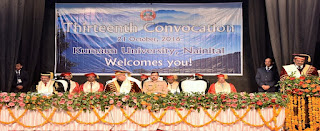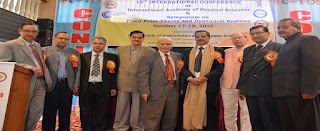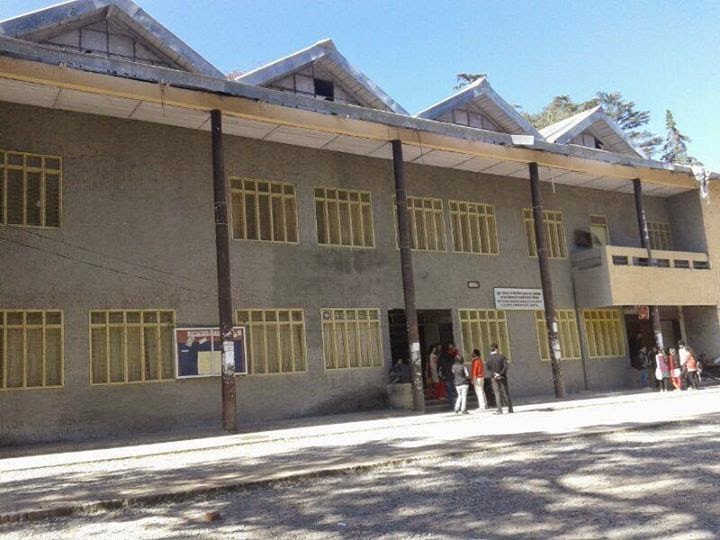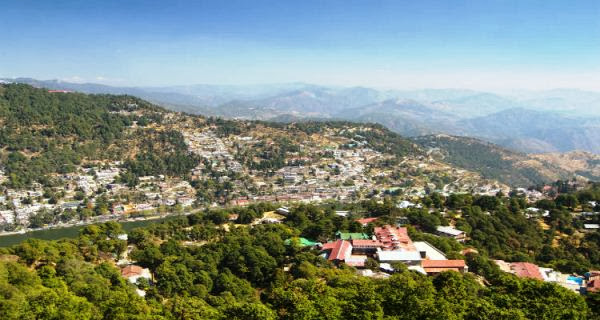Click
to download PDF of Proposed Syllabus for B. Sc. Semester program
implemented from Session 2016-17 of Kumaun University for Physics
Ist Paper: Quantum Mechanics and Relativity
M.M. : 33
Note : This question paper has three sections. Section- A consists of fourteen objective type
questions, each carrying ½ Mark. All questions in this section are compulsory; Section-B consists of ten short answer type questions carrying 2 Marks each. Attempt any seven questions from this Section. Section-C consists of six long answer type questions carrying 4 Marks each. Attempt any three questions from this section. Questions are to be attempted sequentially as far as possible. All the symbols used have their usual meanings.
Quantum Mechanics
Unit-I
Origin of quantum theory, failure of classical Physics to explain the phenomena such as black body spectrum, Photoelectric effect,its characteristics and Einstein’s explanation, Planck’s constant and particle nature of light, Compton effect.
Unit-II
De Broglie’s hypothesis of matter waves, Davisson and Germer experiment, G. P. Thomson experiment, Taylors experiment, Group velocity and wave velocity, wave particle duality, Principle of Complementarity, uncertainty principle, Heisenberg gamma ray microscope , Single slit experiment.
Unit -III
Schrodinger’s equation, Postulatory basis of quantum mechanics, Operators, Expectation values, Importance of wave function, Probability interpretation.
Unit -IV
Applications of Schrodinger’s equation to particle in one-dimensional box, Harmonic oscillator, transmission across a potential barrier, potential well of both finite and infinite depths, Potential step.
Relativity
Unit -V
Michelson Morley experiment, Galilean Invariance, Postulates of special theory of relativity,
Lorentz transformations, Relativity of simultaneity, length contraction, time dilation, law of
addition of velocities , variation of mass with velocity, mass energy equivalence, relativistic
kinetic energy.
Books and References :
1. Quantum Mechanics by L. I. Schiff, McGraw Hill Book Co.
2. Lectures on Quantum theory by Chris. J. Isham, Allied Publisher.
3. Quantum Mechanics by Ghatak & Loknathan.
4. Quantum Mechanics by Mathew & Venkatesan.
5. Introduction to special relativity by R. Resnik.
IInd Paper : Modern Physics
M.M. 33
Note : This question Paper has three Sections. Section-A consists of fourteen objective type
questions, each carrying ½ Mark. All questions in this section are compulsory, Sections –B
consists of ten short answer type questions carrying 2 Marks each. Attempt any seven questions from this Section. Section-C consists of six long answer type questions carrying 4 Marks each. Attempt any three questions from this section. Questions are to be attempted sequentially as far as possible. All the symbols used have their usual meanings.
Unit-I
Electronic specific charge ‘e/m’, Thomson’s model, Rutherford’s atomic model, Bohr’s model and spectra of hydrogen atom, fine structure and other shortcomings. Sommerfeld’s model, Stern Gerlach experiment, Bohr Megneton, Larmor’s precession, vector atom model and spatial quantization and electron spin.
Unit-II
Optical Spectra, spectral notations L-S, J-J coupling, selection rules and intensity rules ,
Explanation of structure of sodium D line. Normal Zeeman effect, X-ray spectra (characteristic and continuous), Moseley’s law.
Unit-III
Luminescence, Spontaneous and induced emissions, Metastable states, Einstein A and B coefficients, Spatial & temporal coherence, optical pumping, population inversion. Conditions of lasing action. Idea of Laser and Maser. Examples of Laser (Ruby Laser, He-Ne Laser, semiconductor Laser) and some applications, Molecular spectra. Rotational, vibrational and electronic energies of a diatomic molecule, Gross features of electronic band spectra, Brief idea of Raman effect.
Unit-IV
Structure of nucleus ; Charge, shape, mass, energy, spin, angular momentum, mass defect,
Packing fraction and binding energy. Liquid drop model and semi empirical mass formula,
Kinematics of nuclear reactions, Basic idea of nuclear fission and fusion, General idea of
elementary particles and their classification.
Unit-V
Artificial nuclear transmutation, Particle accelerators; Van de Graaff generator, Cyclotron. Linear accelerator Particle detectors; Ionization chamber, Proportional counter and G.M. Counter. Radioactivity (Brief idea of decay), Soddy displacement law. Law of radioactive disintegration, half-life and mean life. Radioactive dating (Specially Carbon Dating).
Books and References:
1. Introduction to modern physics- H.S. Mani & Mehta, Allied East West Press.
2. Perspective of Modern Physics- A Beiser, Tata McGraw Hill.
3. Modern Physics by Ahmed & Lal, S Chand& Co.
4. Modern Physics by B.V. N. Rao. New Age International.
5. Fundamentals of Modern Physics by Agarwal & Agrawal, Pragati Prakashan.
6. Basic Nuclear Physics by B.N. Srivastav- Pragati Prakashan
7. Atomic Spectra - H.E.White
8. Introduction to Molecular Physics- G. M. Barrow
9. Molecular Spectroscopy- Banwell
10. Laser & Non Linear Optics- B. B. Laud
IIIrd Paper : Electronics and Solid State Devices
M.M.34
Note : This question Paper has three Sections. Section-A consists of sixteen objective type questions,
each carrying ½ Mark. All questions in this section are compulsory, Sections –B consists of ten short answer type questions carrying 2 Marks each. Attempt any seven questions from this Section. Section-C consists of six long answer type questions carrying 4 Marks each. Attempt any three questions from this section Questions are to be attempted sequentially as far as possible. All the symbols used have their usual meanings.
Unit -I Network analysis and Network theorems
Kirchhoff’s laws, Series, Parallel connections, Network theorems; Superposition, Reciprocity, Thevenins, Nortons, Maximum power transfer theorems, Low Pass and High Pass filters, Four terminal Network, Electronic Measuring Instruments- VTVM, CRO .
Unit-II Solid State Devices
Electronic Devices: General idea of diode, triode, tetrode, pentode and their characteristics,
limitations. Semiconductor Devices, p-n junction semiconductor diodes; Point contact, Zener,
Varactor, tunnel diode, photo diodes, light emitting diode. Junction Transistors, Transistor operation, Characteristic Curves, common emitter, common base and common collector configurations, current amplification, Field effect transistor MOSFETS, UJT, Four layer semiconductor devices (SCR, thyristor), thermistor.
Unit -III Rectifiers, Power supplies and Digital electronics
HW, FW and bridge rectifiers, Filter circuits (Series L., Shunt C., L-Section, π-Section).
Unregulated PS, Regulated PS, Voltage regulation by Zener diode, Voltage multipliers, Binary, Decimal, Hexa decimal and Octal number systems and interconversions. BCD, GREY, EXCESS-3 codes, Logic gates & Boolean Algebra.
Unit-IV Transistor Amplifiers
Classification, Basic Amplifier, Load line, Transistor biasing Transistor equivalent circuits (h-
Parameters). Single stage transistor amplifier, (common emitter, common base) FET amplifiers, R.C. coupled transistor amplifier, Impedance coupled & Transformer coupled amplifier, Noise and distortion in amplifiers, power amplifiers (class A, push pull, class B and class C) Decibel, Frequency response, Bandwidth.
Unit-V Feed back Amplifiers and Oscillators
Classifications, Negative feed back and its advantages, Feed back amplifiers (Voltage and
current) positive feed back oscillators (RC phase shift and Wien bridge , Hartley, Colpitt, Tuned
collector, Tuned base) Oscillators, Negative resistance (Tunnel diode oscillator), Crystal
oscillators, Stability. Relaxation Oscillators- Multivibrators (astable, monostable and bistable),
Schmitt Trigger, Sawtooth generator, Blocking oscillator.
Books and References:
1. Elements of Electronics by M. K. Bagde, S. P. Singh , S. Chand & Company Ltd.
2. Basic Electronics by B. L. Theraja
3. Elements of Electronics by V. K.Mehta
4. Electronics and communication by Kennedy
5. Communication Electronics by Brophy
PDF file of Physics Syllabus of BSc. Kumaun University
Source : Kumaun University




























